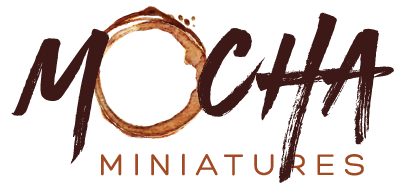Nailed it! I'm finally in a place where I'm proud of the eyes that I paint. While it's not a perfect science, I've dedicated a large amount of time to practicing how to paint eyes and I'm seeing the results of that hard work! I obsess over the eyes of a miniature, as I explained in my last blog post. Facial expressions set the tone, or mood, of the miniature and I prefer to paint them first. If I'm happy with the eyes, there's a good chance I'll enjoy painting the rest of the mini. However, the reverse is also true: if I'm unhappy with a miniature's eyes, it's impossible for me to enjoy painting the rest of it.
Noreth Skyblade · Reaper Miniatures #02994
I've had this particular Reaper miniature on my shelf of shame for over a year. I really like painting elves-- the prettier the better! However, this particular gentleman elf was primed over a year ago and when I started to paint him, I discovered one of my very-talented painter friends had also just painted the same mini. While his version of Noreth is absolutely stunning, I felt discouraged at the time. "There's no way my miniature will ever look that good!" I thought. "I'll just end up being disappointed in the end" so I put him aside in July 2014 and vowed to paint him one day. Last night, I decided I was ready. I patched up some chipped primer (in all honesty, I should have stripped him and started over but I appreciate a good challenge!) His long jacket will be royal blue and I'll be painting some NMM on his boot armor, shield, and sword. I still don't think I'm to the level of Cash's version, but it no longer discourages me-- it inspires me to paint to that advanced skill level. So i started on his jacket base coat and while I waited for it to try, I started on his eyes.
Eyes are a painfully long process and it's something that I put pressure on myself to get "just right". However, I watch a lot of anime, and I'm influenced by that particular stylized eye. I attempt to paint my miniatures with big, expressive eyes and I'd like to incorporate that into my consistent painting style. Here's what I started with last night (see below with paint line-up) and the Instagram photo below that is what I ended up with. It was hard to believe I hadn't picked up my brush since ReaperCon. Over the last week, I've been working on cleaning and assembling new minis, and only now have been able to apply the knowledge that I learned at the Con and apply it to what I'm painting at the time. Something must be working, since I'm now "seeing" things I was unable to identify before attending the Con. Now that I know what I want to see, I attempt to match my expectations to my current skill level-- I was shocked at what I was able to accomplish in a year! While my minis, even my guys, have heavy outlines around their eyes, I like it-- it's my preference, since I appreciate painting clean, high contrast when it comes to expressive faces. It takes considerably longer, but it's hard to argue with the results!
In addition to Noreth, I'm also working on Dannin Deepaxe, a Dwarven Reaper mini I've owned for a long time. She's been cleaned up and primed (despite the constant rainy weather we've been having!) She's a smaller sculpt than humans, so I thought her eyes would be more difficult to paint. However, Werner Klocke sculpts some big eyes for painters to enjoy and play around with. He really does a great job with this, and I'm able to push-the-envelope when it comes to painting interesting eyes! Next up for these miniatures-- hair! I haven't decided on color scheme, but I hope to be struck with inspiration tomorrow when I pick up my brush. Some days I have it, others I don't-- let's hope tomorrow's another "great painting day". Wish me luck!












